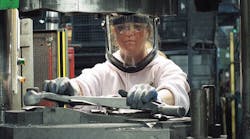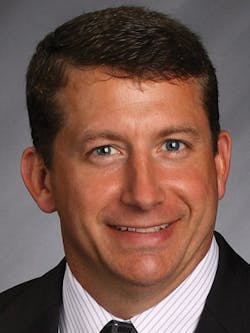There will be a sense of continuity and familiarity at the C-level of Waupaca Foundry Inc. when president and chief operating officer Mike Nikolai takes up his new appointment as CEO this summer. But, that stability may contrast with the scale of change and development the Wisconsin-based metalcasting group has set forth for the coming three years. The organization is shifting resources, redefining its production profile, and expanding its portfolio, all in line with the February merger with Hitachi Metals Automotive Components. In the future, the business will remain centered on cast iron parts, particularly for the automotive sector, but the range of products and service it provides is intended to be more complete and more adaptive to changes in its customer base.
Nikolai is taking the role long held by Waupaca Foundry CEO Gary Gigante, who is retiring after a 35-year career with the group. Also retiring is EVP, Sales and Marketing, Kris Pfaehler, whose role will be filled by John Wiesbrock.
Under Gigante, Waupaca Foundry presented a model for steadiness in the metalcasting industry, navigating several ownership changes but maintaining its portfolio of six plants in good standing, even within a industry roiled by high operating costs and uncertain demand, especially from the automotive market. Hitachi Metals Ltd., the Japanese industrial group, bought the group for a reported $1.3 billion in 2014.
By that purchase, Hitachi gained a large-scale components manufacturing enterprise, and Waupaca gained access to the Hitachi engineering and design resources, as well as additional automotive supply-chain access. Earlier this year, the Waupaca foundries and the Hitachi Metals Automotive Components plants were combined, adding a Lawrenceville, PA, ductile iron foundry to the portfolio. Two auto parts machining and assembly plants from the HMAC organization, in Effingham, IL, and Wellsboro, PA, are added to the group, too. These operations will continue to produce and market Hitachi Metals’ brand products (including HNM™ series high-strength ductile and Hercunite™ series heat-resistant castings.)
Nikolai will have experience on his side as he oversees the organization. He began his Waupaca Foundry career 23 years ago as an intern, but he has been a metallurgist and production manager for gray and ductile iron, a plant manager, and vice president of operation. He was appointed president and COO in April 2015. Nikolai is a graduate of the University of Wisconsin-Madison, and he holds master’s degrees in metallurgical engineering and business administration (MBA.)
What happens to Waupaca in the next three years will fulfill the Hitachi strategy that began two years ago. A four-point plan revealed in April seeks to build on the advantages of the Hitachi connection, and to get the most value out of Waupaca’s position in a still-thriving automotive market. “The merger positions Waupaca Foundry to meet evolving customer needs for cast, machined, and assembled iron castings,” according to Nikolai. “We are better able to streamline the supply chain for casting buyers and fulfill plans to increase revenue and profitability.”
The first point of the plan is to convert Waupaca’s Etowah, TN, foundry to producing ductile iron casting exclusively. Nikolai said that this move allows the newly incorporated Lawrenceville foundry to shift some orders and maximize its production of specially engineered, lightweight HMAC suspension parts. The Tennessee foundry is able to accommodate the additional ductile iron programs, while the five other Waupaca foundries can absorb its gray iron programs. By shifting the workloads, Nikolai explained in an interview, Lawrenceville can “continue to grow the proprietary alloy and product design elements of their business, at which they have been very successful,” and both sides of the new organization can benefit from the synergy that the merger created.
While that first step addresses the current needs of the HMAC product line, the second initiative will refashion how Waupaca works with its automotive-sector customers (OEMs and Tier 1 suppliers) in a broader way. The goal is to establish a network of specialty machine-shop partners that will locate near to the foundries and execute specific programs to fulfill Waupaca’s end-customers’ requirements.
From the perspective of casting buyers, this will allow OEMs or Tiers to assign work to “a one-stop shop,” in Nikolai’s phrasing, and reduce their obligations to working with multiple suppliers. But, from the Waupaca perspective, it magnifies the synergy created by the HMAC merger. Whereas Waupaca gains engineering and design expertise from that connection, it is able to extend the value of those components through the casting and machining phases of production, delivering a fully finished part all the way through the automotive supply chain.
“Our customers are looking for assembly-ready components that they can put into a vehicle, so we’re responding to that,” explained EVP John Wiesbrock, whose responsibilities include defining and managing the new Waupaca supply chain structure.
Wiesbrock underscored the point that Waupaca’s strategy is not to become a fully vertically integrated supplier, because the group remains a metalcasting organization. Rather, it is to give the automotive sector the same advantages of vertical integration that HMAC suspension-components customers gain by way of the specialty machining plants in Wellsboro, PA, and Effingham, IL. The new partnerships Waupaca develops with machine shops near its foundries will achieve that, he concluded.
The third initiative will alter another detail of Waupaca Foundry’s profile. Long recognized for its expertise at vertical molding, it now plans to install a horizontal molding line at the Tell City, IN, foundry. A ductile iron molding line will be replaced with a new operation using technology Hitachi has established at foundries in Japan and South Korea. Nikolai emphasized that Waupaca will be relying on that expertise to impact a North American market with a horizontal molding operation that will be better than any now available.
“The feedback we’re getting from the market is that there is a limited capacity now for this type of product, … so we’re reacting to the customers’ needs,” he explained. The new molding line will increase the Tell City plant’s overall molding capacity, and would maximize the tonnage of the melt center there, he said.
The last, and most ambitious, initiative in the three-year plan will fulfill Hitachi Metals’ objective to be active in Mexico’s automotive casting sector. According to Nikolai, Waupaca is “open to all possibilities,” listing a greenfield development or an acquisition, but the specific plan remains under wraps. He acknowledged that “Level 1 engineering work” had been completed toward a greenfield project, confirmed that the operation would controlled by Hitachi/Waupaca, and he predicted that strategy would be realized within the three-year term.
A new executive with an ambitious three-year plan is entitled to be confident and optimistic, but Nikolai remained steady in his forecast of the automotive market on which Waupaca Foundry’s prospects rest. He noted the group has long strived to balance its reliance on the automotive sector with other, “commodity” driven markets for iron castings, like commercial vehicles and heavy equipment. While those markets currently offer little prospect for expansion, he expressed confidence that automakers would continue to increase their demand for castings.
But, he predicted those demands would be depend on a metalcasting supplier being able to shift its production capabilities in synch with OEMs’ changing programs; to design or redesign cast parts according to program or model changes; to define or redefine material choices, according to lightweighting or other objectives; and to increase the scope of its services and the availability of its resources to suit the automotive buyer’s needs. And Waupaca Foundry’s strategy is to be that supplier.











